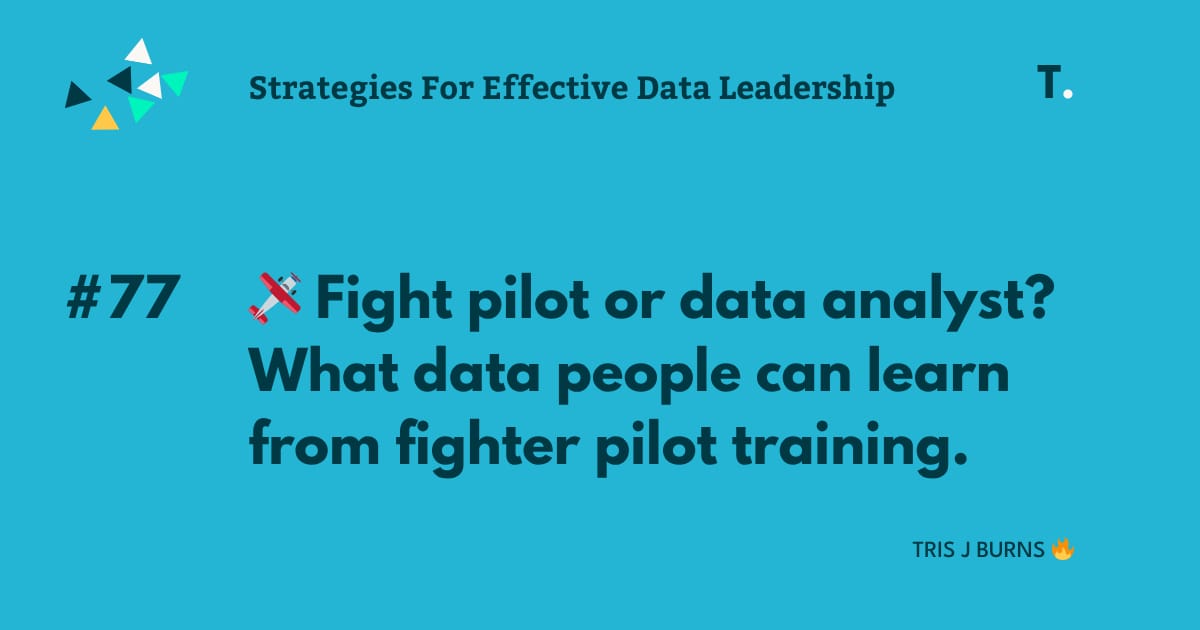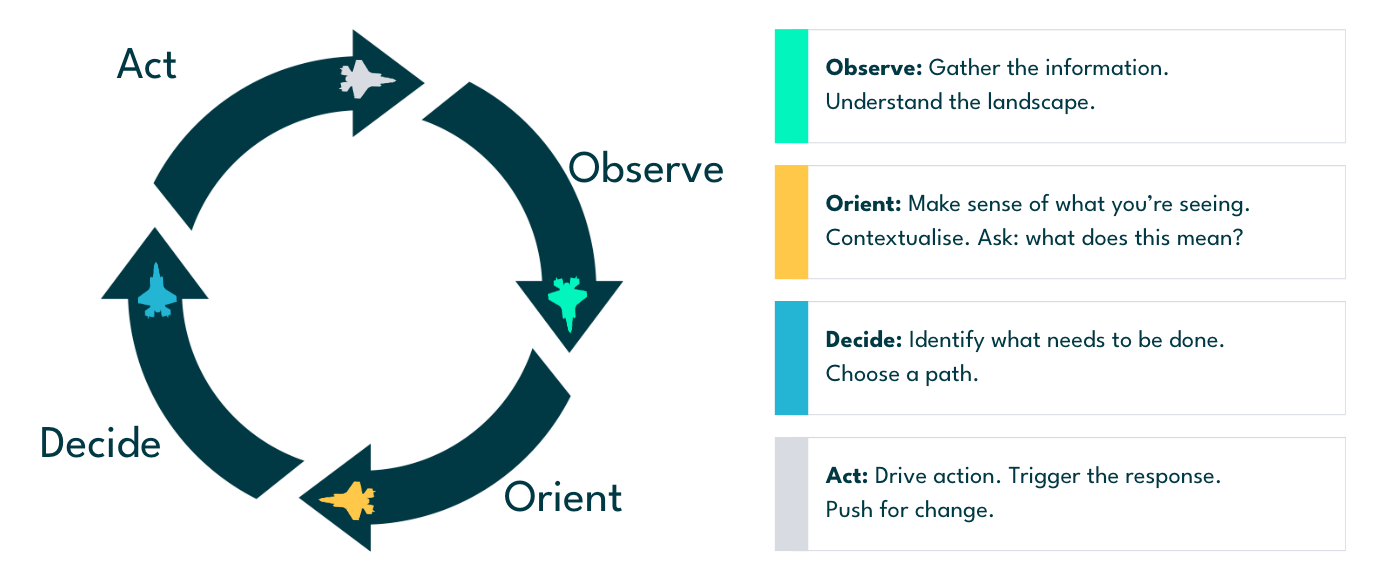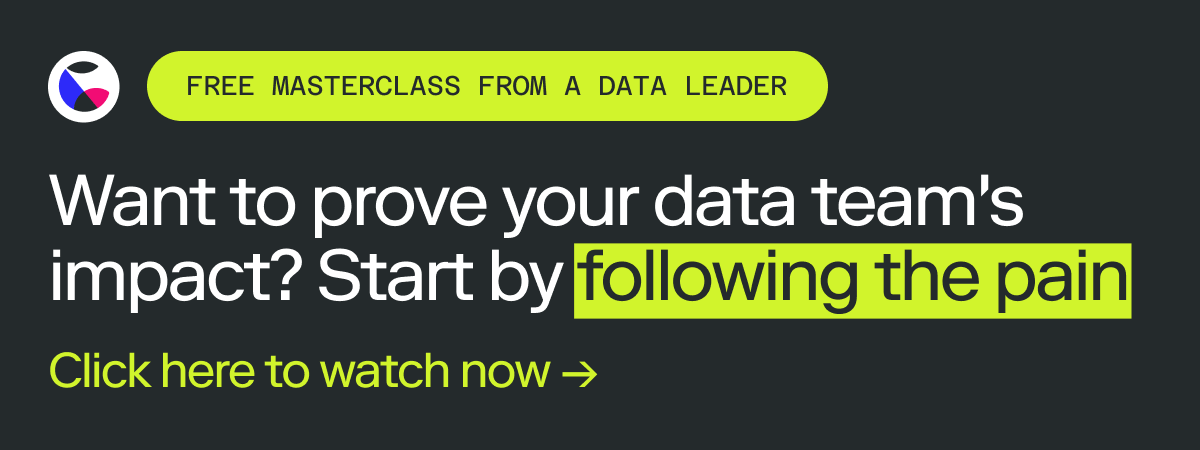
READ TIME: 6 MINUTES
In partnership with Count.co
“I want to be the person who can translate between the creative world and the data world.” — Tiankai Feng, Director of Data & AI Strategy at Thoughtworks.
In this conversation with Count CEO Ollie Hughes, Tiankai explores how data success depends on more than just tools—it requires empathy, storytelling, and trust. Drawing from his book Humanizing Data Strategy, he shares lessons from leading data at Thoughtworks and how to bridge the gap between data teams and stakeholders.
This webinar will reshape how you think about data strategy.
🤔 "You think up there, you're dead." - Viper
When you’re strapped to a rocket doing Mach 2 and people are trying to kill you, you’re going to need to make decisions very quickly. But what this quote from Top Gun 1 gets dangerously wrong is the idea that thinking is your enemy.
In today’s post, I’m going to dive into a fighter pilot training concept that is all about teaching pilots how to analyse, think and decide so that they can maximise speed whilst minimising risk.
As I’ll show you, it’s also a powerful analogy for any data professional looking to be more strategic and impactful in how they contribute to their organisation’s success.

I have this exact flight suit…
Be a fighter pilot, not a flight recorder
A good analyst observes.
A great analyst acts.
The concept used in military aviation we’re going to look at today is known as the “O-O-D-A Loop”.
It stands for:
Observe 👀
Orient 🧭
Decide💡
Act 🎬
It’s the mental model fighter pilots use to make high-speed decisions in complex, high-stakes environments.
It’s also a perfect framework for how great data analysts and leaders should work with business data.
📋 Missed my new guide for data leaders?
“The 5 Traps Keeping You Stuck” is now live. Check it out here.
🛩️ Here’s how it works both in the sky, and in data:
Observe: Gather the information. Understand the landscape.
Orient: Make sense of what you’re seeing. Contextualise. Ask: what does this mean?
Decide: Identify what needs to be done. Choose a path.
Act: Drive action. Trigger the response. Push for change.

Feel free to steal this…. I did.
🗳️ But before we go further, a little poll for you
Which part of the “OODA loop” do you or your team most often get stuck in?
Most analysts, and most data teams, never get past the first step.
They simply observe. They report. They pass the insight back to the business and say, “Here’s what’s happening.”
And then they wait for someone else to decide what to do about it.
That’s not analysis. That’s data transcription.
If you want to be a strategic partner, you have to complete the loop.
You start by observing that the data is telling you
You then orient your insights around the business context.
You decide what the recommendation needs to be.
And you need to help act on that insight, whether that’s pushing for a decision, influencing a plan, or triggering a change.
🔥 Did you know you can sponsor this newsletter?
If you’re interested in getting your brand’s name in front of senior data decision makers across the US, UK and EU then check out my sponsorships media kit to find out how
🧑✈️ Here’s how to train your team like fighter pilots:
✅ Don’t just ask for numbers, ask for next steps
Every analysis should come with a point of view. What should we do now?
✅ Bring in business context
Analysts should understand how their insights fit into the wider business priorities. Orient around business goals and objectives, not just data.
✅ Make recommendations part of every deliverable
Train your team to include a recommended action or hypothesis in every report, dashboard or presentation. Data with out a ‘so what’ seriously undermines your team’s usefulness.
✅ Be willing to take a position
You don’t need to be 100 percent certain to offer a view. You need to be directionally useful. How do you expect others to make a decision based around your data, if you’re not willing to do so for yourselves?
✅ Create feedback loops
Make sure your team knows what happened after their insight was delivered. Did the business act on it? What was the result? Tie outcomes to team productivity. You’ll forever be seen a as a cost centre until you do this.
Most data teams act like black boxes. Data goes in, a report comes out.
But that’s not the case with high performers.
They operate more like fighter pilots: fast, informed, decisive.
They finish the loop 🔄
Be more pilot. Less reporting monkey. 🐵
🔥 Summer is heating up
If you’re a data leader who’s feeling a little stuck, you’re not alone.
Everyday, I speak with data leaders all over the world who are struggling with the pressures of the role, and feeling like their impact is not what it needs to be.
They want to stop being treated as the organisation’s help desk/punching bag and start feeling like they have an influential voice and a role to play in the organisation’s success.
In most cases, with just a few tweaks and assumptions challenged, you too can become the strategic powerhouse data leader you’ve always seen yourself as.
Book a free 1:1 coaching intro call with me today to find out how we can accomplish this together. Hit me up here.
*BTW I would do it now, because come August, my prices are getting a well deserved bump 😉
📹 I’m on the ‘gram. Come see me!
🧠 Data community recommendations:
The Analytics Ladder is a brand new newsletter from Thomas Laubli
The Analytics Ladder is the weekly playbook for analytics professionals ready to break through career plateaus and land leadership roles with $25K+ salary jumps.
Check it out here!

Tristan Burns
💡 Helpful resources for data professionals:
The Data Leadership Frameworks: This email series containing 10 data leadership frameworks, will equip you with the necessary skills and knowledge to maximise your effectiveness and become the influential and powerful data leader you know you can be.
DIY Coaching Program: Through a series of 9 self-guided exercises, you’ll clarify your goals, overcome obstacles, and create a plan for your next career move - all at your own pace.
⚡️Three more ways I can help you:
Private Coaching for Data Leaders: I work with data professionals looking to grow into influential and unstoppable data leaders to help them navigate and overcome the challenges of being a data leader.
Group coaching for Data Teams: Great data teams can make or break businesses. Through my facilitated 6-week group coaching program, together we get to the heart of what is holding teams back and set a course for data-driven success.
Google Analytics, Tagging and Looker Support: Helping teams to set up or optimising their data eco system, generate actionable insights and gain more in-depth knowledge through training.
What did you think of this email?
If you enjoyed this newsletter, why not forward it to a friend.
Did someone forward you this email? You can subscribe to Strategies for Effective Data Leaders here!



